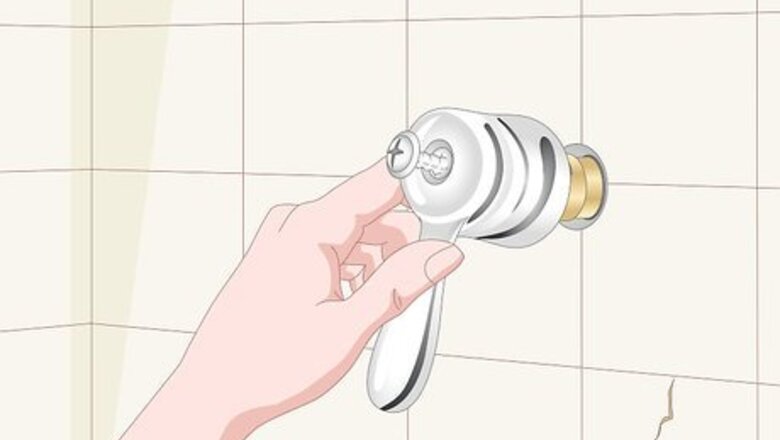
views
Replacing Shower or Wall Tiles
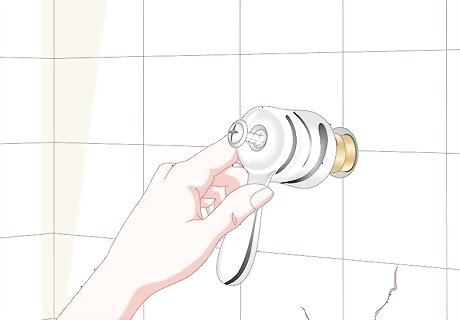
Remove any fixtures that surround your tiles to prevent damage. Check if any of the tiles you’re replacing intersect with any of the fixtures in your shower, such as the shower head, faucet, or overflow drain. Unscrew or pull the fixtures off of the wall and set them aside for now so you can reinstall them later on. You don’t need to remove the fixtures if you’re only replacing single tiles that aren’t in the way of your fixtures. If you don’t feel comfortable taking out the fixtures yourself, then contact a plumber or a contractor to come do the work for you.
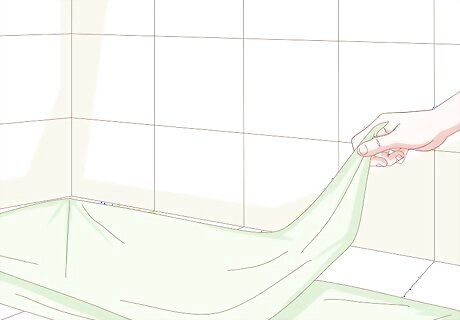
Cover your workspace and drains with a drop cloth to prevent any damage. Falling tile pieces can scratch or damage your bath or flooring underneath them. Spread a drop cloth over the entire area where you’re working and use painter’s tape to secure it in place so it doesn’t slip or move around. Make sure the tub drain is completely covered if you’re removing shower tiles so none of the pieces get stuck in your pipes. If you don’t have a drop cloth, you can use old bedsheets instead.
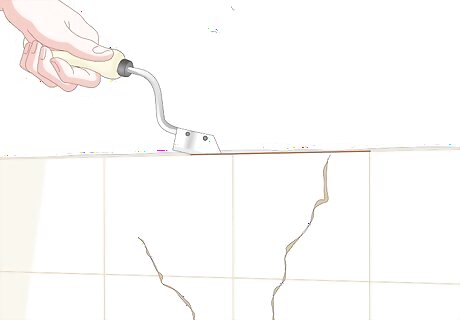
Cut through the grout around the tiles with a grout removal tool. Grout removal tools have saw-like teeth that easily grind through grout to make it easier to remove. Start the blade in one corner of the tile and pull it straight across the grout to cut into it. Go over the area a few times applying a medium amount of pressure to completely remove the grout. Cut through each line of grout around the tile so you’re able to pry it out of place. Work through the grout around 1 tile at a time so it’s easier to remove. You don’t have to remove the grout from the tiles at this point if you don’t want to, but it makes the tiles easier to remove and will help keep your workspace cleaner.
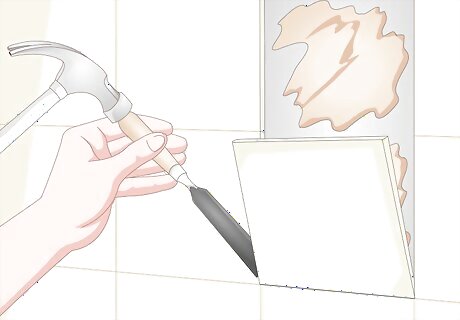
Pry the tiles off of the wall with a hammer and flat chisel. Start at the outer edge of the top row of tiles to make them the easiest to remove. Hold the end of a flat chisel against the edge of the tile at a 30-degree angle. Tap the other end of the chisel with a hammer to force the chisel under the tile and remove it from the wall. Work completely across each row from top to bottom. Put on work gloves and safety glasses to protect yourself from any tile shards or sharp edges. Wear long pants while you’re working since the tiles could fall and cut you. The old tiles may break when you chisel them out of place or when they fall down.Tip: If you’re replacing a single wall tile in the middle of other tiles, drill a hole in the center of it and start your chisel in the middle. This way, you’re less likely to damage any of the other tiles.
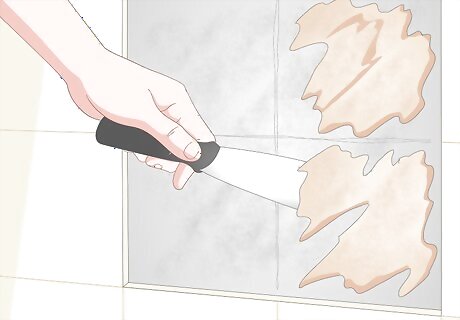
Scrape off any leftover adhesive with a metal scraper. After you remove all of the tiles, there may still be some sections of mortar still stuck on your wall. Hold a metal scraper at a 45-degree angle to the adhesive and apply a firm amount of pressure to lift up the adhesive. Continue scraping it to remove as much as you can before moving on. If you have trouble removing the mortar with a metal scraper, use your flat chisel and a hammer to apply more pressure.
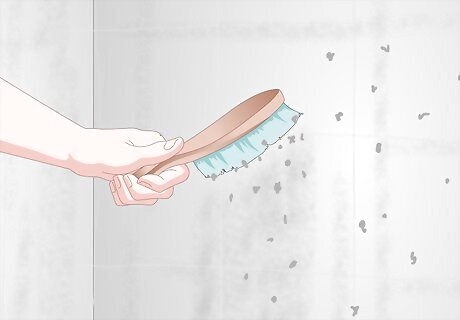
Brush the drywall so you can get a clean application. Use a stiff-bristled shop brush to wipe any dust or debris from the area. Start at the top of your wall and brush in short strokes down to push any residual material onto your drop cloth. Continue brushing the wall until you don’t see it lift up any more dust. You can also use the hose attachment on your vacuum to clean your walls, but make sure you don’t suck up large tile pieces since they could cut the hose or damage the inside of your vacuum.
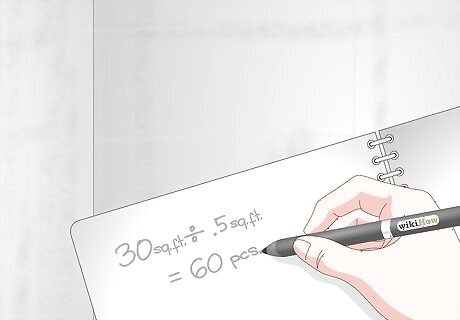
Measure and plan the tile layout. Find the dimensions of the area where you plan on reinstalling new tiles and write them down so you don’t forget. Then check the dimensions of the tiles you’re using to see how they will fit on your wall. Calculate the area of the wall and divide it by the area of a single tile so you know how many tiles you need for your space. Choose to line up your new tiles in a grid pattern or offset them slightly to make the space more visually interesting. For example, if your bathroom wall is 30 square feet (2.8 m) and your tiles each cover ⁄2 square foot (0.046 m), then you’ll need 60 tiles total. You don’t need to plan a layout if you’re only replacing a single tile, but make sure the measurements are the same. You may need to cut the tiles to a specific size if they don’t perfectly fit on your wall.
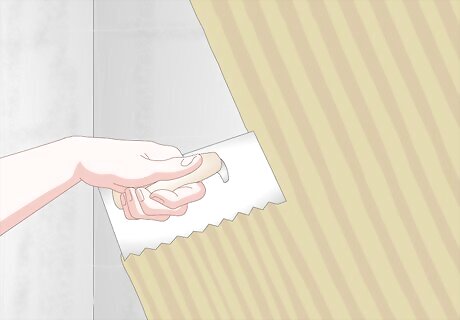
Spread a thin layer of tile mortar onto your wall with a square notch trowel. Scoop out a large blob of the tile mortar from the container and spread it on your wall. Only cover a section that’s about 3–4 square feet (0.28–0.37 m) so it doesn’t dry before you’re able to place your tiles. Drag the edge of a square notch trowel over the mortar to leave grooves in it so the mortar has room to expand when you press a tile onto it. You can either buy premixed tile mortar or you can mix it yourself.Tip: If you’re applying a single wall tile, then apply the mortar to the back of the tile instead of directly on the wall so the mortar doesn’t set on the surface of another nearby tile.
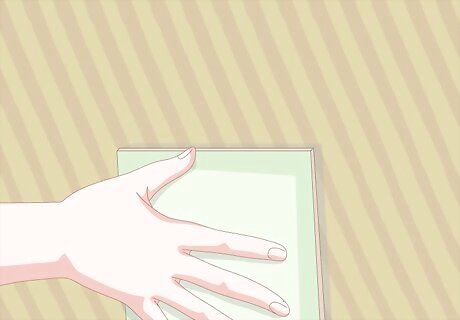
Push the tile onto the mortar so it holds in place. Hold the tile carefully by the edges and line it up on your wall so it’s even and level. Push the tile into the space where you want to put it and press it firmly against the wall so it sticks to the mortar. Apply pressure to the entire surface of the tile to get an even mortar application on the back. If you want to check if there’s enough mortar, slowly peel the tile off the wall and check the back to see if it has even mortar coverage.
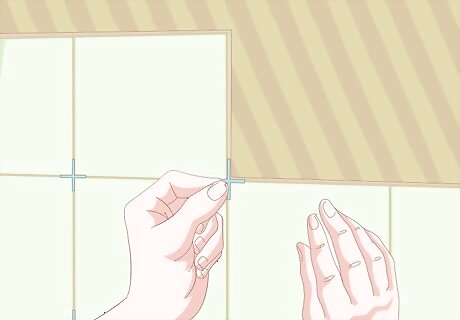
Install the other tiles on your wall with spacers in between them. Work in horizontal rows from the bottom to the top so the tiles look even and level. Continue applying more mortar as you need to install your new tiles and press them into place so they stick to the wall. Slide 1-2 spacers on every side of the tiles so they stay a uniform distance apart, or else they’ll get crooked. Let the mortar set for 24 hours so it can dry. You can buy tile spacers from your local hardware store. Make sure that the tiles are pressed the same depth against the wall or else they’ll be uneven.
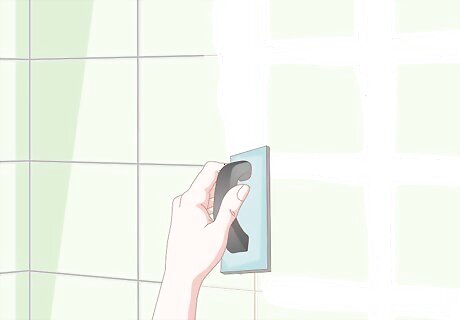
Apply grout to your tiles after the mortar sets for 24 hours. Pull the spacers out from your wall so you have a clean work surface. Follow the directions on the package of grout and mix it until it has a thick enough consistency where you can form it into a ball. Pick up some of the grout on the end of a rubber grout float, which is like a squeegee, and work it into the spaces between the tiles. Start at the edges of your tiles and pull the float across the edges diagonally to force the grout inside. You can buy grout and a grout float from your local hardware store. Make sure to evenly apply your grout so it doesn’t look thicker or thinner in any spots.
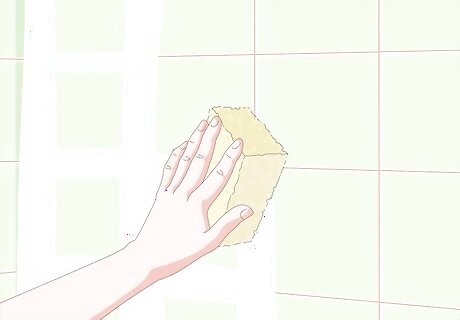
Wipe off any residual grout with a clean sponge. After about 20 minutes, wet a sponge under warm water and wring it out so it isn’t dripping wet. Wipe the surface of the tiles to remove any grout that’s stuck on them. Rinse the sponge when it looks dirty and continue cleaning off your tiles until there isn’t any grout left on the surface. Be careful not to remove any of the grout from between your tiles since it may still be slightly wet.
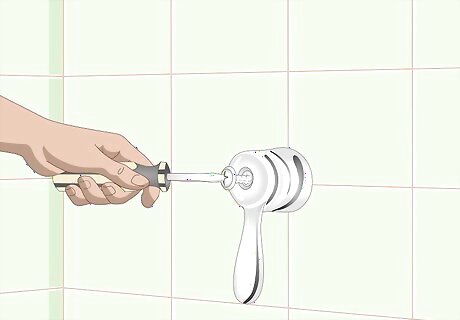
Reinstall your fixtures once the grout sets. Wait at least 1 day for your grout to completely set between your tiles so it hardens completely. Reattach the fixtures by reversing the process you used to remove them. Make sure they’re tightly secured to the wall so they don’t cause any leaks or damage to the tiles. You may need to caulk around some fixtures so water can’t get inside or underneath them.
Changing out Floor Tiles

Scrape the grout out from between the tiles. Use a grout removal tool with a serrated edge to cut through the grout between your tiles. Start near the corner of one of your tiles and apply a firm amount of pressure to dig into the grout. Pull the grout removal tool between the tiles 3-4 times to cut out as much as you can from the wall. Continue scraping the grout between each of tiles you plan on replacing. You can buy grout removal tools from your local hardware store. Remove all the grout and take out 1 tile at a time to make your workload easier.
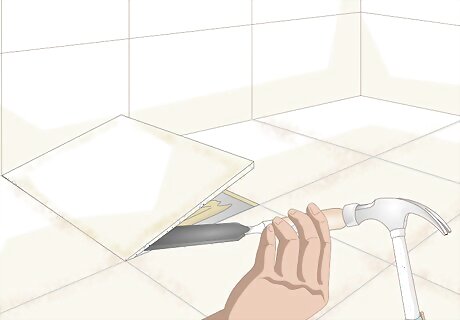
Pry the tiles up from the floor with a hammer and chisel. Position the flat end of your chisel on the edge of the tile you’re removing at a 30-degree angle. Lightly tap the end of the chisel with a hammer or rubber mallet to break the tile off of your floor. If you can’t lift the tile after hitting it from one side, try positioning your chisel on the opposite side and prying it from there. Continue removing the other tiles the same way. Begin on one of the tiles along the outer edge of your room if you plan on replacing the whole tile floor so you have an easier starting point. If you work slowly and carefully, you may be able to remove your floor tiles without breaking them.Tip: Keep a box or a trash can nearby to throw away the tiles as you remove them so your workspace doesn’t get as dirty.
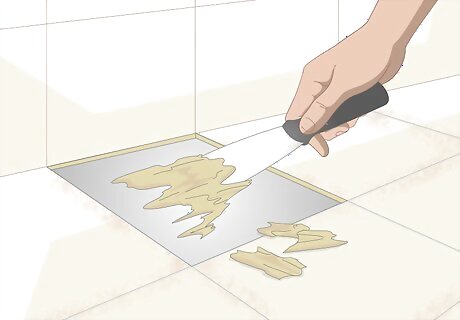
Remove the residual adhesive with a metal scraper. Hold a metal scraper at a 45-degree angle to your floor at the edge of the mortar that’s still stuck. Apply a firm amount pressure and push the scraper forward to lift up the adhesive. Continue working across the surface of your floor until you’ve lifted as much of the mortar as you can. Use your chisel and a hammer to pry stuck-on adhesive if you aren’t able to lift it with a metal scraper.
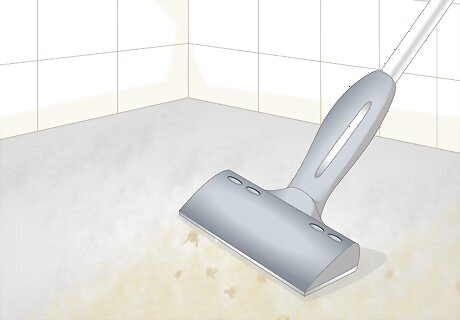
Vacuum your bathroom to remove any dust or debris. Your tiles will leave shards and dust in your bathroom, which may prevent your new tile from staying in place. Use the hose attachment on your vacuum to lift up small bits of tile or adhesive that you weren’t able to clean up easily. Continue working until you’ve removed as much of the debris as you can. Don’t use your vacuum on shards that are larger than a coin since you could damage the hoses or bag.
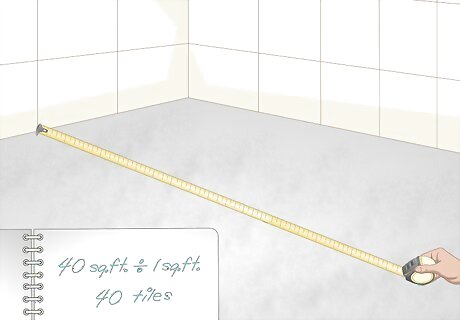
Measure and plan the layout for your floor tiles. Find the dimensions of your bathroom and write them down so you can see how many tiles will fit. Then take measurements of the new tiles that you plan on installing so you can start designing how you want to place them. Calculate the total area of your bathroom and divide it by the area of 1 tile so you know how many you need to get. Lay your tiles on the floor to plan how you want them to look when you’re finished. For example, if you have a bathroom that’s 40 square feet (3.7 m) and each tile covers 1 square foot (0.093 m), then you’ll need 40 tiles total. You can choose to lay out your tiles in any pattern you want, but you may need to cut some if they don’t fit in the space. Take multiple pictures of your layouts so you can compare them side by side. You do not need to plan a layout if you’re only replacing a single tile.
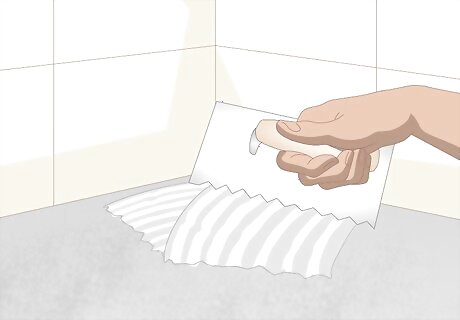
Apply thin-set onto a 3–4 sq ft (0.28–0.37 m) section of your floor. Start on the side of your bathroom furthest from the door. Buy premixed thin-set or follow the directions carefully on a powdered mix so you get the right consistency. Use a square notch trowel to spread the thin-set over an area that’s 3–4 square feet (0.28–0.37 m) so it can’t dry before you place the tiles. Go over the thin-set with the notched side of the trowel to make grooves in it so the tile sticks better. If you’re only replacing a single tile, you can either spread the thin-set onto the back of the tile or into the space where you’re placing the tile.
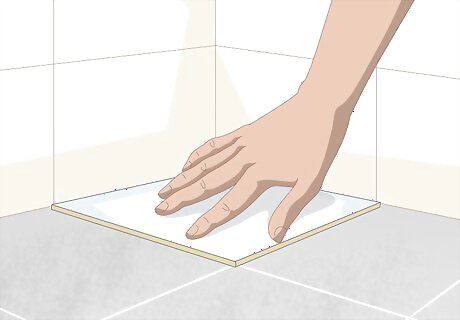
Push the tile into place on the thin-set. Line up the tile with the area where you want to place it and carefully set it down in place. Apply a firm amount of pressure so it firmly adheres to the thin-set and make sure the tile stays straight so it doesn’t appear crooked. If you need to apply more pressure to the tile, lightly tap it with a rubber mallet until it sets into place. Set a level on top of the tile to make sure it’s flat on top of the thin-set. If it’s not, apply pressure to the raised sides.
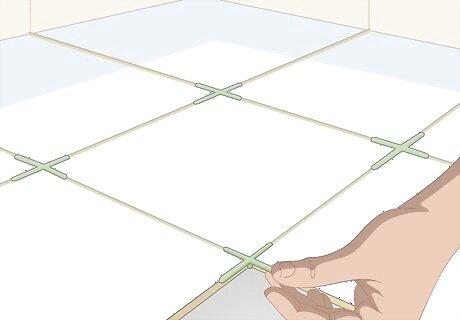
Continue adding tiles to your floor with spacers in between them. Work in horizontal rows across your bathroom floor so you can ensure your tiles stay straight. Spread more thin-set on the floor when you need it and place the next tiles adjacent for the first one. Check that the tiles are level with one another before sliding 1-2 spacers between them so they stay the same distance apart. Place the same number of spacers between all of your tiles so the floor looks uniform and even. You can buy spacers that also help level your floors to make your workload easier. Work from the furthest corner of your bathroom toward the door so you have an easy way to get out when you’re finished laying the tiles.
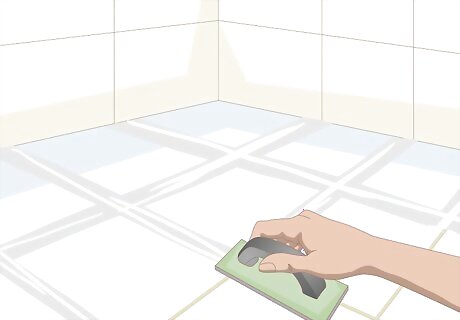
Spread grout in the spaces between the tiles once the thin-set is dry. Leave the thin-set to dry for at least 24 hours before pulling the spacers out from between your tiles. Mix your grout following the package’s instructions and scoop some out with a rubber grout float. Push the grout float diagonally into the spaces between your tiles to force the grout between them. Check that the top of the grout is even with the top of the tile and fills in the space completely. If the application looks uneven, then wipe out any excess with a shop cloth. You can buy grout from your local hardware or home improvement store. Don’t use a regular trowel for spreading your grout since you may scratch or damage your new tiles.
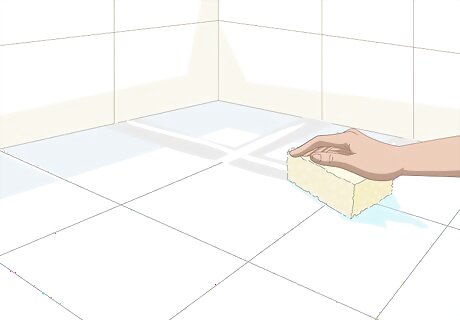
Wipe away excess grout with a damp sponge. About 20 minutes after you apply the grout, wet a sponge under warm water and wring it out so it’s damp to the touch. Carefully clean the tiles on your floor to remove any grout that’s still on their surfaces. Be careful not to remove any of the grout between the tiles since it still may be wet.

















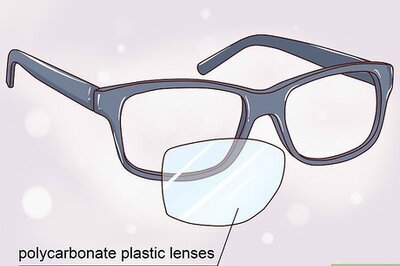

Comments
0 comment